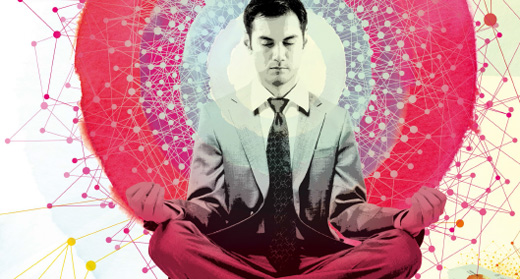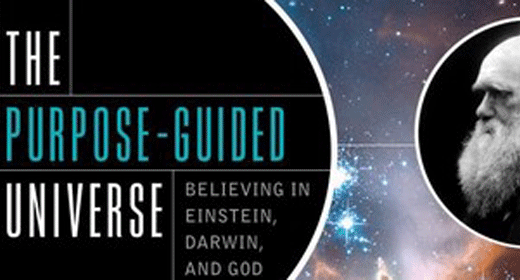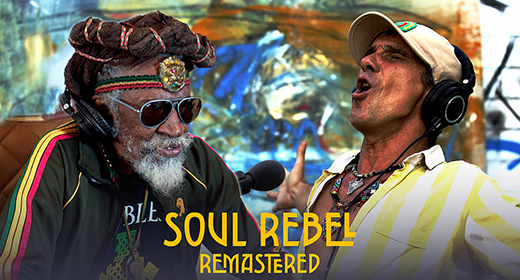Gopi Kallayil: The trend toward enlightened thinking in the high-tech world yields wisdom for all of us about how to stay connected with our inner technologies as well as our electronics.

At first glance, Gopi Kallayil’s life appears to be consumed by technology. A Google marketing manager, Kallayil has a high-pressure, 60-hour-a-week job in the heart of Silicon Valley, which means: video conference meetings with co-workers all over the world; tactics sessions in HQ war rooms; upwards of 500 emails a day to manage via computer and smartphone; a blog; and Twitter and Google + accounts. He is a prime candidate for a distressing case of info-overload, but the soft-spoken Kallayil seems happy and unruffled. On the phone and in person, he’s energetic and engaged, and shows nary a sign of distraction.
Kallayil’s data-saturated worklife might be extreme, but it’s not unusual in today’s always-connected world. What’s surprising is his response to the crush of data that threatens to take up his every waking moment. He shuns multitasking and gives his full attention to one thing at a time. He even looks forward to long stoplights—not for the opportunity to glance at his latest text messages, but for giving him a moment to be mindful and present and to remind himself that there’s more to life than the Web and Wall Street.”I perform a gratitude practice on my drive to work every day,” he says. “I count 10 things that I’m grateful for.”
On the surface, the 24/7 pace and digital distractions of high-tech living appear antithetical to inner wisdom practices like meditation. Our myriad devices tempt us with endless stimuli that invite our attention to go off in a million scattered directions at once, while meditation narrows our focus to a single subject—the in-depth study of our own mind.
You might not think of the digerati—the people who populate the upper echelons of the high-tech world and whose very jobs often exist to stoke your compulsive need for silicon-infused connectivity—as contemplative types. But what’s perhaps most intriguing about Kallayil, a graduate of both the University of Pennsylvania’s Wharton School of Business and a Sivananda Yoga teacher training program, is that he’s not alone. Kallayil is one of a small yet growing number of elite technology executives that make practices like yoga, meditation, and self-inquiry a significant part of their lives. Indeed, decision makers at Internet companies ranging from the software start-up asana to the gaming juggernaut Zynga are showing their commitment to actively advancing our possibilities in an externally wired world, even as they strive to better understand their own internal wiring.
The Cost of Roaming
You could argue that our pervasive relationship with technology is in deep opposition to the fundamentals of meditation and spiritual life. The compulsive checking of messages, staying connected because you’re afraid of missing out, or answering a late-night work email because it makes you feel needed can all be powerful distractions from knowing your true self. Wisdom practices, on the other hand, invite you to set worldly matters aside for a few moments, to cut yourself loose from the ego, and to experience yourself free from external affirmations and influences. Is it even possible to enjoy a quiet mind or pursue an experience of your true nature if you’re caught up in rapid-fire tweets or are busy measuring your popularity via Facebook “likes”? Soren Gordhamer believes it is and feels technology itself may prove an ally in the quest for mindfulness. Certainly, he dismisses the idea that we need to leave our smartphones behind to discover nirvana.
“There must be some middle ground where we’re not just shunning technology,” he says. “A place where we can still take advantage of all the amazing things technology provides—like search services and real contact with family and friends.”
Gordhamer, 43, is the de facto spokesperson for the intersection of the mindfulness movement and the technology industry. He believes that we should em-brace and champion technology as long as we bring the same quality of attention to our relationship with our iPhones and iPads that we bring to our meditation and yoga practices.
“When my cell phone rings and I notice anticipation and nervousness inside me about what the call might represent, I bring consciousness to the moment. I’ll ask myself where I’m looking for something to satisfy,” he says. “Suddenly the phone is a teacher.”
In other words, Gordhamer thinks we can avoid a different kind of “roaming charge”—the emotional or psychic cost connected with the distraction and expectation associated with that phone, wherever and whenever it might be ringing—by remaining as attuned to our inner technologies as we are to our outer ones.
Gordhamer, who divides his time between Dixon, New Mexico, and the San Francisco Bay Area, didn’t always have such an integrated approach. In 2003, while attempting to create a new Internet company, he worked all day and surfed and networked all night. The computer screen was his constant companion. And while Gordhamer welcomed the virtual interactions, he knew that the seductiveness of data streams and technology kept him from going outside, spending time with his son, and practicing asana. Gordhamer, whose father is a psychologist with a passion for meditation, had grown up listening to his dad quote the words of mindfulness-community icons like Ram Dass. But the more time Gordhamer spent at the computer, the more his asana and meditation practices suffered.
“I came to believe that technology was having an increasingly negative impact on my life,” he says. “And I thought, ‘Wow, if I’m struggling with this, I bet thousands of other people are struggling, too.’ ”
Wisdom in Real Time
In 2008, Gordhamer wrote a snippet-filled how-to book aimed at techies that suggests, among other things, that yogic philosophy can help readers stay in touch with themselves despite the many distractions that exist in their 21st-century lives. In Wisdom 2.0: Ancient Secrets for the Creative & Constantly Connected, Gordhamer proposes that anyone—whether or not you’re a titan of tech—can reduce stress and increase dynamic thinking by embracing practices like nonjudgment, doing deep breathing, and taking in less information. He quotes such disparate cultural heroes as Mahatma Gandhi and Steve Jobs, and he gives sections of the book slightly geeky but empowering titles like “The Search Engine: Go for Truth.”
Building on his book, with one foot in each of two seemingly un-related worlds, Gordhamer decided to bring the tech and spiritual communities together in real time. “I met a few people at Google and Twitter,” he recalls. “I kept saying to them, ‘How do we live mindfully in a constantly connected age? Wisdom traditions have some piece of that answer. Technology has some piece of that answer. Those two worlds need to come together for us to find a full answer.’ ”
The result was an annual conference called Wisdom 2.0, which for the past two years has taken place at the Computer History Museum in Mountain View, California—the very heart of Silicon Valley. The conference has drawn an impressive collection of leaders from the worlds of technology and spirituality—a who’s who of speakers including Tony Hsieh, the CEO of billion-dollar online shoe company Zappos; Greg Pass, former chief technology officer of Twitter; Stuart Crabb, the head of learning and development at Facebook; U.S. Representative Tim Ryan; Zen Buddhist Roshi Joan Halifax; yoga instructor Seane Corn; meditation teachers Jack Kornfield and Sharon Salzberg; and Yoga Journal editor in chief Kaitlin Quistgaard.
In this town built on the trappings of ego—IPOs, wealth, and the desire for success,—the sold-out conference (whose live webcast last year logged 284,000 views) offers participants a chance for an unprecedented multilayered conversation about having a meaningful inner life while maintaining a connected outer one.
Last year, the Buddhist meditation teacher Jon Kabat-Zinn led a conference-wide meditation intended to push some members of the audience where they had perhaps never gone before: to be fully present with themselves, to notice how fast their minds race, to feel where they hold tension in their bodies, and to focus on what is arguably the single most important ingredient of any person’s existence—not the Internet, not the latest app, but the breath. Kabat-Zinn instructed everyone to rest in his and her awareness, “as if your very life depended on it, which it does, in more ways than you can possibly think.” And for the next few moments, there wasn’t a peep or tweet out of the inward-looking crowd.
Piqued Performance
Why would some of the sharpest minds in and around Silicon Valley stop working and inventing long enough to explore introspective practices like yoga and meditation? Perhaps because we’re talking about exactly that: the thinking of some very sharp minds.
Yoga and meditation, after all, offer tech execs, managers, and engineers the same benefits they offer the rest of us: the ability to stay calm amid a storm of emails and projects; the perception that work is only part of a broader existence; the chance to reset and start each day anew. To this end, many tech companies offer their employees yoga and meditation along with a variety of other holistic wellness benefits. The 35-year-old biotechnology pioneer Genentech, which was first to discover how to synthesize both human insulin and growth hormone, sponsors in-house mindfulness programs. The productivity software start-up Asana offers employees individual and group yoga classes. The social network gaming company Zynga, which brought you FarmVille and CityVille, among other games, pays for reflexology and nutrition advice in addition to yoga and meditation classes. Such investments are made in particular to help employees achieve that elusive state of mind where inspiration and great work come relatively quickly and easily.
“For all the CEOs trying to create billion-dollar companies, I have some advice: One key to success is the subtle art of teasing out people’s enlightened states,” says Eric Schiermeyer, co-founder of Zynga. “I think leaders need to promote the methods that bring out such key qualities in a workforce.”
Schiermeyer doesn’t go so far as to claim a linear relationship between, for example, practicing asana and coming up with a new and improved version of a product like CityVille. But, he insists, “every time you have insights into your work, you’re taking advantage of the process of consciousness that these practices are proven to enhance.”
Earlier in his career, Schiermeyer, who helped propel Zynga into last summer’s billion-dollar initial public offering, spent years working 18-hour days, gulping down Red Bulls, and staring at computer screens. A bleeding ulcer and hospitalization made him pause and reflect on his lifestyle. A martial arts practitioner since college, Schiermeyer ultimately turned to a regular meditation and yoga practice as part of a commitment to live a more balanced life.
Information Filters
Increased productivity aside, lots of high-level techies turn to yoga and meditation because, by itself, the tech industry cycle of innovate, dominate, and wealth-create doesn’t add up to a satisfying existence. These power players have come to understand that cultivating an inner life brings calm and consciousness that make their everyday existence, in and out of business meetings, with or without laptop or cell phone in hand, far more gratifying.
“By itself, my work provides a lot of excitement, stress, and material fulfillment,” says Kallayil, the Google marketing manager who practices being fully present and attuned at red lights. “But there continues to be a hole in one’s existence, a yearning that I believe can be filled via wisdom traditions.”
Kallayil began teaching yoga on the company’s Mountain View campus in 2006. In good weather, a dozen or more “yoglers,” as he and his yoga-practicing colleagues call themselves, will enjoy class outside on a slab of sun-warmed cement surrounded by long green reeds and near a fountain that sounds like a babbling brook. Virtually no deadline or work matter keeps Kallayil from teaching the Monday evening class.
In his own yoga practice, Kallayil allows himself to get lost in the rhythms of breathing and familiar movements. These moments of simplification, of distilling life down to breath and motion, compose him, he says, and inform his behavior when he reenters the frenetic pace of the multitasking-minded world of technology.
“More and more, I find myself preferring to do one thing and do it well,” says Kallayil. “I go to a meeting and see that others have three or four chats going on on their screens. Instead, I appreciate what’s going on in front of me. In the end, maybe 90 percent of the information popping up onto my screen won’t serve me in the moment anyway.”
Kallayil does his best to share this perspective with yoglers beyond Google’s sprawling Silicon Valley campus. He leads Google yoga classes around the world when company business takes him to satellite offices in places like Beijing, Buenos Aires, and Tokyo. While teaching, he encourages his students to distill their thoughts and actions, however briefly, down to what is necessary in that moment. He promotes the idea that navigating life via one’s internal compass can help us all to “get past the fear that being temporarily disconnected means you’re out of the loop.”
Kallayil has twice escorted groups of a dozen or more yoglers to weekend retreats at a Sivananda ashram in Grass Valley, California, where they eat, meditate, and practice asana together. Shockingly, some of the yoglers take a break from their email while they’re away, which allows them to be more present with their teachers and fellow visitors at the ashram. Many of the yoglers, Kallayil says, learn from the experience that presence equals a different kind of connection.
Google vice president Bradley Horowitz, who oversees hugely popular communications products like Gmail and the new social network Google+, says he meditates regularly “to let go of any sense of life’s work ever being done.” Horowitz knows all too well that there will always be more to do, whether in his meditation practice or in an effort to please the millions of Internet-surfing consumers who use his products around the globe, 24/7.
“There’s no point at which I can go to sleep with the world in order,” he says. And so while Horowitz works very hard, he unhesitatingly uses words like “surrender” and “trust” to characterize his feelings about an ever-evolving inner life and an external life filled with work demands and a flood of emails, texts, and data.
Words to Text and Call By
So what can you learn from the technology industry about bringing consciousness to your relationship with the digital universe? About maintaining presence and inner connection in a world designed to pull you, in every waking moment, outside of yourself?
First of all, you needn’t surrender your iPad, smartphone, or laptop. You can live with the latest technology and still have a connected inner life. Presenters at last year’s Wisdom 2.0 conference offered attendees suggestions for bridging the two worlds. Take a segmented approach to work—intense spurts of productivity interspersed with reflective downtime. Let your cell phone ring several times before you answer, and then give the call your full presence. Let some of your email go unanswered. And evaluate your relationship with technology instead of blaming it when you feel distracted.
Start With One Breath
But perhaps the most important lesson to be learned from Silicon Valley’s titans of digital technology is this: If these folks can make time in their day for yoga and meditation, so can you. At last year’s Wisdom 2.0 conference, Kallayil described how he had once set a goal for himself of performing 60 minutes of yoga and 30 minutes of meditation per day. But he found himself too encumbered by work commitments, and he failed. Then someone suggested that Kallayil start with “one breath.” He realized that meditating, even for an hour, was nothing if not hundreds of single breaths strung together.
“I committed: ‘Every day I will do one minute of yoga and one minute of meditation.’ This sounds ridiculous,” he said, “but something shifted inside of me, because there’s no day that I don’t have 60 seconds.”
Kallayil did it for a week, and then for a month. After a while, his sessions went longer. He’d sit on the cushion and say, “What am I rushing off to? What is more important than this?”
Apparently, just about nothing else.









































